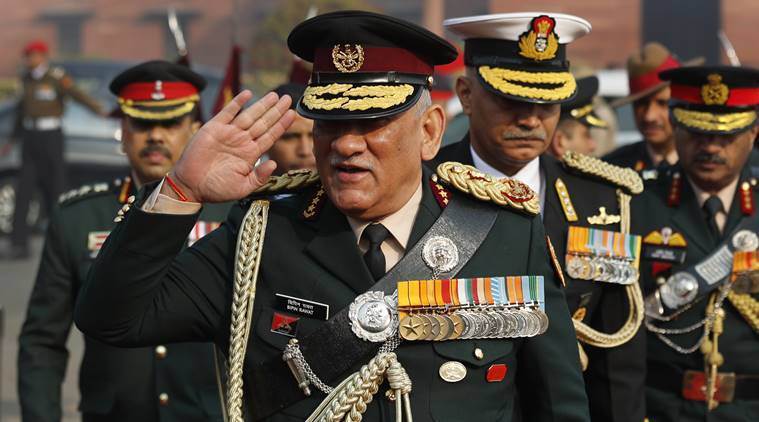 Chief of Defence Staff (CDS) General Bipin Rawat. (AP Photo/File)
Chief of Defence Staff (CDS) General Bipin Rawat. (AP Photo/File)
It has been suggested that the newly-created post of the Chief of Defence Staff (CDS) proceed slowly and think through the issues, along with the service chiefs, before making pronouncements. There have been several reports in the media that suggest that the entire concept of Theatre Commands and the functioning of the Departmant of Military Affairs (DMA) have already been fully conceptualised. At this juncture, revisiting the report of the post-Kargil task force report may be useful. The report included important inputs from all former chiefs of staff as well as government functionaries who dealt with issues of national security.
The major areas in which changes were needed were higher defence management, jointness in operations as would be necessary in any future conflicts, and associated requirements of national security. In addition, a review of defence procurement/indigenous production, the DRDO, policy research and manpower were also looked at. Change comes with many complexities and in this regard, “speed must be tempered by caution and logical thought”. The welcome impetus for change has finally come from the political leadership. It places a responsibility on the CDS and service chiefs to chart out a clear roadmap for the required changes. It must be kept in mind that — as defined by the government — the forces will continue to be operationally commanded by the respective chiefs, who should not face any ambiguity as regards their roles and functions. Media reports since the creation of CDS seem to suggest that the complexities of the entire process of this change does not seem to reflect the inputs from the service chiefs. The CDS is only the “first amongst equals” and it is essential that the views of the service chiefs are also taken into account, particularly if they are contrarian.
Let us start with the proposed structure for the predominately maritime theatre — the Peninsula Theatre subsuming the Western Naval Command (WNC), Eastern Naval Command, Eastern Naval Command, Southern Naval Command and Southern Air Command. The suggested structure reflects, once again, sea blindness. We need to comprehend the Navy’s extent of maritime responsibilities, including search and rescue, and the interests of the country’s Exclusive Economic Zone and the tasks/ missions that complement national diplomacy requirements. These extend to the Indian Ocean and, increasingly, the Asia Pacific regions. The navy does not guard borders but manages maritime frontiers and attendant activities. The complexities of maritime activities clearly bring out that one theatre command for the maritime responsibilities (7,612 kms and island territories) of the Navy is functionally inadequate and unacceptable. It is almost as laughable the suggestion that HQ WNC should be relocated to the sea border with Pakistan.
Next, let us look at manpower (MP) issues. Countries with sizeable armed forces have rationalised (read reduced) MP as part of restructuring. The best and most recent example is China, which has reduced the size of the PLA from 4.5 million to 1.8 million as a part of the creation of joint military regions. The excess MP has been transferred to the Peoples Armed Police. We need to be serious about our excess MP levels and the concomitant expenditure. Static peace-time infrastructure needs to be suitably cut down. We need to move away from assessing our combat ratio and budget projections on the basis of boots on the ground. MP rendered surplus must be compulsorily absorbed with paramilitary forces, thereby effecting savings in pensions instead of increasing retirement ages. Increasing the retirement age to reduce pensions is not the answer, as the armed forces need a youthful profile.
In the 1960s, the Government of India had engaged US consultants (Arthur D Little) to conceptualise defence production. One of the key recommendations was the creation of partnerships between the public and private sectors. This was not allowed to happen for many years. Hence, the private sector was not given an opportunity. It may be interesting note that the Navy was a pioneer in establishing a capable defence shipyard in Mazagaon. However, despite such achievements, we have had the dubious distinction of being the biggest importer of armaments. Clearly there is national capability and we need to set our house in order.
The restructuring of military regions in China commenced in the mid-1950s and was carried out over three phases. Their 12 separate commands were rationalised, and now number five. From the statements made publicly, it seems we are planning to complete some of our restructuring in a matter of months. Clearly, this is an unrealistic timeframe.
The primary task for CDS is to define — through consultations with service chiefs and operational commanders — a suitable defence policy for the country. Once accepted by the government, this should become the basis for determining the defence budget, for which the CDS has to justify to the Cabinet Committee on Security. Thereafter, the CDS, once again in consultation with service chiefs, is to recommend which areas must receive priority in terms of spending. Should there be any differences among them, these too have to be brought out.
Finally, my suggestion for the CDS is to take a balanced and consultative approach in defence restructuring. There are no prizes for chasing unrealistic timeframes. Let us maintain an even keel.
This article appeared in the print edition on March 6, 2020 under the title ‘Slow and steady’. The writer is a retired vice admiral of the Indian Navy and former flag officer Commanding in Chief, Western Naval Command.